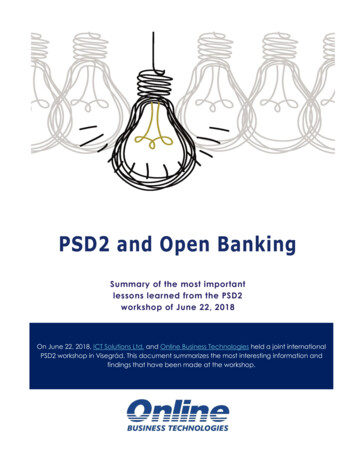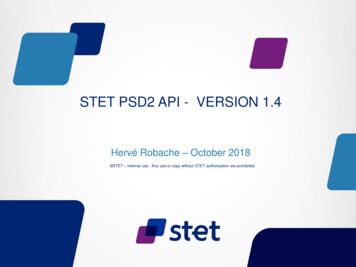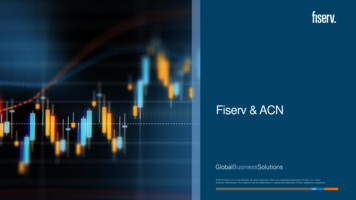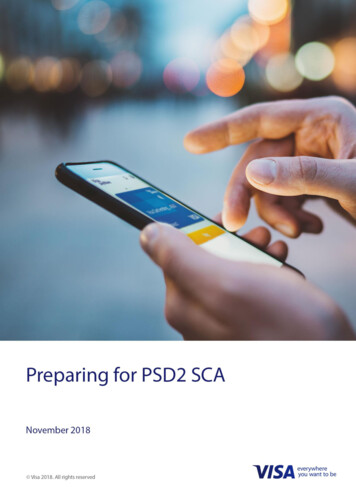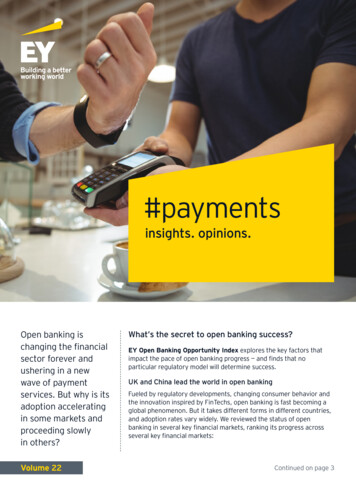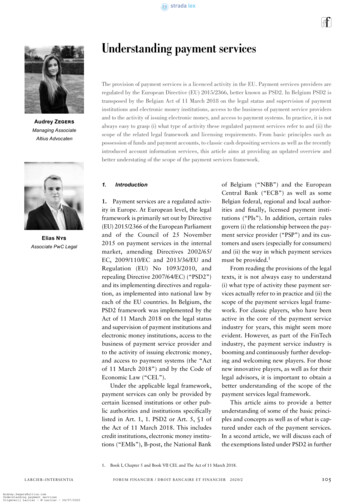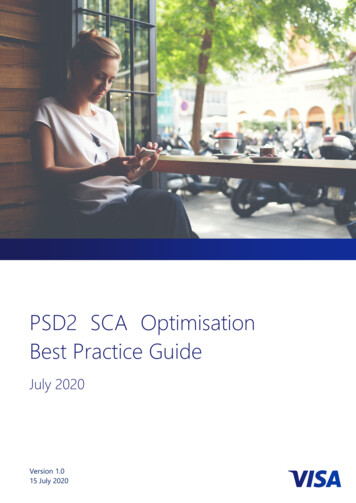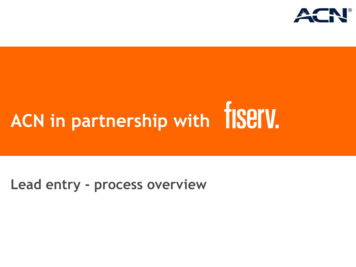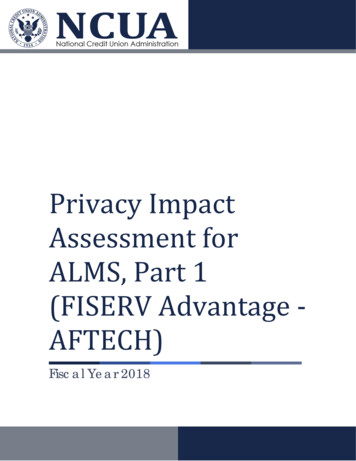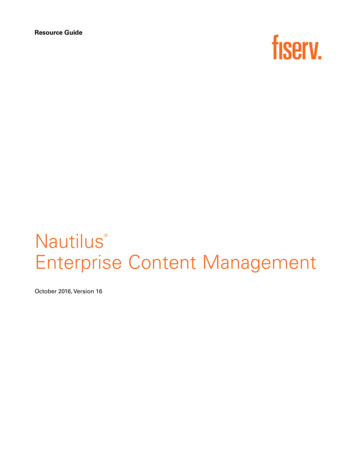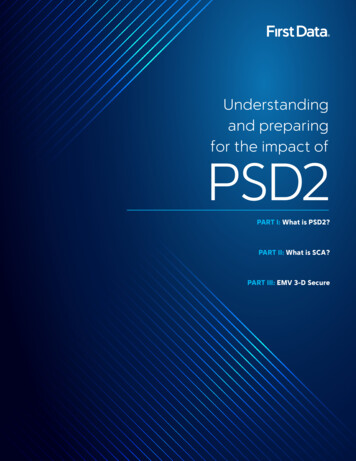
Transcription
Understandingand preparingfor the impact ofPSD2PART I: What is PSD2?PART II: What is SCA?PART III: EMV 3-D Secure
Just as “no man is an island,” the success of acompany does not stand on a single person.This is especially true at First Data, where every employee is considered an “Owner-Associate.”This not only gives them a stake in the company, but also makes everyone accountable forcompany growth. Thankfully, the collective expertise of our team supports our ability to innovateand deliver solutions that help drive the new world of global digital commerce.Jay AblianJacqueline HerschHead of Merchant Security & FraudDirector, Merchant FraudJay Ablian currently manages the strategicdirection and growth of First Data’s Securityand Fraud Solutions, including productsdesigned to boost fraud prevention, detectionand resolution for merchants. Previously, hewas BluePay’s EVP and GM of partnerships,until First Data completed their acquisitionlate 2017. He then transitioned to First Data’sVP of Business Development for IntegratedPartnerships where he leveraged his 17 years ofprogressive payment advancement experienceto manage strategic business development.Prior to joining First Data he held positions atValkre Solutions, Tribune Company, Motorola,Millicom, A.T. Kearney, and Ernst and Young.Jacqueline is the product owner of First Data’s3-D Secure Solutions and shapes the valuepropositions and go-to-market strategies.Her extensive knowledge stretches acrossDigital Payments, including Value AddedServices, Security & Fraud Services and TokenServices. Prior to joining First Data, she wasVice President of Product Development andBusiness Strategy for Michael C. Fina andAffinity Solutions. Her payments expertise goesback to an accumulative 15 years with Fiservand American Express.Collin FlottaVP, Global Digital CommerceCollin is an award winning payments executivewith a reputation for consistently exceedingthe most challenging objectives. Some of hisachievements include recognition by the IndianPresident and Reserve Bank of India for thesuccessful implementation of PaySecure withNPCI, has created industry-leading smartphoneapplications, and has successfully definedand implemented the largest deploymentof “internet of things” to date. In his currentrole he navigates the ever-evolving world ofEmerging Payments and helps clients betterunderstand the future of commerce.Peter O’HalloranVP, Global Digital CommercePeter joined First Data in 2013 and isresponsible eCommerce strategy andcommercialization throughout EMEA, APAC &LATAM. This includes partnership formations,top-line eCommerce revenue growth throughexisting First Data sales channels, andincreasing the addressable market throughproduct innovation and client acquisition. Heis also the Non-Executive director for FirstData PolCard and is on the European AdvisoryBoard for the Merchant Risk Council. Prior tojoining First Data, Peter was Head of Gift &Loyalty for Payzone Group, Co-Founder andCPO of Branded Payment Solutions and ledManaged Services at Realex Payments.Nandan ShethHead of Global Digital CommerceNandan is a seasoned innovator with over20 years of FinTech experience within largecorporation and high-growth, venture capitalbacked companies. He is the founder of threedisruptive FinTech ventures: CollectionsX,Harbor Payments, and Acculynk. His expertiseincludes cross-border commerce, online/mobilecommerce, debit/alternative payments, B2Breceivables/payables, and online bill pay.
2007December 25, 2007PSD1 comes into forceExecutive Summary2013July 2013First PSD2 proposal by EC2015October 8, 2015PSD2 approved byEuropean ParliamentUnderstanding andpreparing for theimpact of PSD2.PSD2 is the revised Payment Services Directive enacted by theEuropean Commission (EC) on January 13, 2018. It is scheduled totake full effect on September 14, 2019, at which time providers willneed to implement the technical requirements, including StrongCustomer Authentication (SCA), outlined in PSD2.November 16, 2015PSD2 passed by EU2016Its mandates are far-reaching, affecting not only enterprises within the EuropeanJanuary 12, 2016PSD2 comes into forceUnion but also any online retailer with European customers. In fact, to increasesecurity for remote transactions in their own countries, many non-EU governmentshave adopted some of the mandates first proposed by the EC.So, no matter where our clients conduct their business, it’s critical they have aAugust 12, 2016Start of SCA consultation periodworking understanding of PSD2, its provisions, and some of the solutions that canhelp make compliance possible.October 12, 2016End of SCA consultation periodIt’s our hope that by going through this material, and understanding its content,our clients will be better prepared for the changes ahead.2017February 23, 2017Final draft of SCA publishedAs always, First Data stands ready to help our customers navigate new revenuestreams that are safer, and that have greater potential than ever before. This is justthe beginning of our lasting journey together.OBJECTIVES2019January 13, 2019PSD2 national legislation implementedApril 20193-D Secure liability shiftSeptember 14, 2019SCA requirements enforced in Europe Explore the origins of PSD2, what it was designed to do,its drivers and key provisions, important dates, and its effect onestablished players and on new entrants in the market. Explain Strong Customer Authentication, as a key component of PSD2,and as an increasingly widespread mandate for countries around theworld. Look at EMV 3-D Secure, a leading solution designed to satisfy theSCA mandate, and that helps make online transactions safer and morefrictionless compared to its previous version.
PART I:What isPSD2?
What is PSD2?The revised Directive on Payment Services, known as PSD2, is a mandatethat governs regulated payment service providers within the EuropeanUnion and the European Economic Area. It is designed to increasecompetition and participation in the European payments system formerchants and other stakeholders.When does it apply?All electronic payment transactions where either the buyer or the selleruses an EU-based regulated payment service provider are potentiallysubject to PSD2 mandates.1What are the key dates?PSD2 has been in place since January 13, 2018. However, it won’tcome into full effect until September 14, 2019, which is the deadlinefor providers to comply with PSD2’s technical requirements, includingStrong Customer Authentication.2 (See Section Two).
BackgroundIn seeking to create more competition for digital transactions, and ultimately,better services for European customers, the European Commission (EC) in 2012published a Green Paper entitled “Towards an integrated European market forcard, internet and mobile payments.”3“We have already used EU competition rules to ensure thatnew and innovative players can compete for digital paymentservices alongside banks and other traditional providers. Thenew Directive will greatly benefit European consumers bymaking it easier to shop online and enabling new services toenter the market to manage their bank accounts.”4Margrethe Vestager,European Commissioner for CompetitionTo that end, the EC has identified four mainPSD2 drivers and their benefits:5More competitionMore choice and transparency for the consumerMore innovationMore payment security and customer trust
More CompetitionThe EC wants to lessen the dominance of American card schemes Visaand Mastercard, which are used in nearly 87% of global transactions.6It hopes that by adopting open standards, providers would offertheir payments solutions in more than one country, giving rise toincreased competition.More choice and transparencyfor the consumerPreviously, electronic payment transactions were controlled by a relativelysmall number of larger providers—mainly banks—who often had hiddencosts and limited services.PSD2 is designed to open access to customers’ bank accounts to thirdparty providers who can debit and credit those accounts directly. Withbetter insights into what they are getting and associated cost, it’s hopedthat customers will choose providers with the best rates and services.Up to87%of globaltransactionsused Visa andMastercard vi
More innovationThe EC is looking to drive down the cost of entry and isencouraging innovative companies to test the market withnew products.With full EU-wide scale now possible, innovations by new orexisting companies will likely be rewarded more quickly.More payment securityand customer trustSeeking to replicate the success of EMV card chips,which reduced fraud at the point-of-sale, the EC is nowmandating new safeguards to protect remote transactions.The EC hopes these safeguards will boost consumerconfidence in electronic and mobile payments andsubsequently increase online vendor revenue.
Key provisions:ONEGive Third-Party Payment Providers (TPP’s) access to payment accounts.Banks must grant TPP’s access to consumer’s payment accounts (XS2A).7Two new types of TPP’s have been defined:a. Account Information Service Providers (AISP) – AISP’s offer online serviceswhich can provide a consolidated view of a consumer’s payment accounts.b. Payment Initiation Service Providers (PISP) – PISP’s initiate paymenttransactions at the request of the consumer from an account held by theconsumer at another payment service provider.TWOIntroduce Strong Customer Authentication (SCA). Subject to certain exemptions,SCA is mandated for electronic payment transactions and requires authenticationby two or more independent factors.THREE Reduce consumer liability. Excluding fraud or gross negligence, a consumer’smaximum liability for an unauthorized transaction is reduced from 150 to 50.8FOURProhibit surcharging on card payments. Surcharges must not be applied toany transaction made with a consumer card that is accepted in accordancewith the European Union’s regulation on interchange fees for card-basedpayment transactions.9
What effect will PSD2 have on incumbents?Banks: Face increased competition from AISPs and PISPs and a loss in issuing and paymentsrevenue potentially offset by cost reductions. Banks can monetize data made available viaopen APIs and offer third-party products and services or become a PISP or AISP.Card Schemes: Face revenue and market share erosion. Card schemes can diversify bybecoming PISPs or AISPs.Merchants: Will have more choice for payments, but will need to make investments forenablement and there could be a potential conversion rate drop-off due to SCA.Payment Processors: Face increased competition from AISPs and PISPs and the cost ofenabling bank account payments, but they can also become AISPs and PISPs.PSPs and Acquirers: Face increased competition from AISPs and PISPs, bear the cost ofenabling bank account payments and revenue and market share erosion, but they canalso become AISPs and PISPs.
What effect willPSD2 have onnew players?PSD2 and the drive for third party access to accounts and openbanking standards provide opportunities for new entrants to thepayments market, including:AISPs: Will be able to offer value-added services such as dataaggregation, identity verification and data analytics.PISPs: Will be able to initiate payments without using a cardnetwork, helping to reduce cost latency and friction.We’re ready to help.First Data has 19,000 owner-associates inEurope and around the world, processing 3,000transactions per second.100 countries trust First Data to handle the lifeblood of their eCommerce economy.We’re the only Financial Technology company in the world that dedicates that level ofsecurity and scale to this enterprise solution.There’s no better time than now to develop and enhance your global eCommercestrategy to thrive under these changing PSD2 requirements. And, there’s no betterpartner than First Data to help craft an integrated solution that optimizes and maximizesyour digital commerce revenue.
PART II:What isSCA?
What is SCA?SCA stands for Strong Customer Authentication. It is a key mandate included in the PSD2 within the EuropeanEconomic Area (EEA) that requires electronic payments initiated by the buyer to be authenticated by at least twoindependent factors. The European Union (EU) passed the SCA mandate to ensure electronic payment methods arecarried out in a secure manner with as little fraud as possible. The EU believes the changes will create a trustedenvironment in which consumer spending will grow, and payment innovations will thrive. The European Parliamentbelieves SCA will lead to healthy, sustained economic growth for the entire region.To whom does SCA apply? SCA applies only to non-exempt1 electronic transactions that occur entirely within the EU/EEA. This means the cardissuer and the merchant/acquirer are in the EEA. For merchants located outside the EEA, SCA applies only on a best-effort basis. However, if a non-EEA merchantdoes not use SCA, they will be liable for any fraudulent transactions. If a merchant is located within the EEA, but the consumer is using a card issued outside the EEA, SCA does not apply.3,4What arethe key dates?September 14, 2019, is the deadline forproviders to comply with the SCAtechnical requirements.51Applies to all in-scope transactions unless exempted by the legislation.
BackgroundWith the accelerated growth of electronic payments, Europeanauthorities recognized that to have a healthy economy, they wouldneed to protect remote payments. SCA grew out of this need toprotect electronic payment transactions, including E-payments(online/internet) and M-payments (mobile devices), with similarprotections afforded to in-person transactions using EMV chips.Some examples of these types of transactions include the following:5 Online payment account services, such as balance inquiry, reviewof statements, whitelisting of trusted beneficiaries, or blockbeneficiaries Initiation of electronic payments, such as card payments, credittransfers, e-money transactions, and direct debits.
Two-Factor AuthenticationThe main requirement of SCA is that all non-exempt and customer-initiated electronic payments areauthenticated using at least two of the three specified independent factors. The factors are deemed“independent” when they are derived from discrete sources, defined as follows:Something you knowSomething you possessSomething you arePasswordMobile PhoneFingerprintPassphraseWearable DeviceFacial FeaturesPINSmart CardVoice PatternsSequenceTokenIris FormatSecret FactBadgeDNA SignatureFor Strong Customer Authentication, the factors can be either two of these independent elements or something thatworks only when all the elements have been provided (e.g., an algorithm in a chip produces a one-time password orcryptogram, based on a response to a PIN request).6
Additional Risk-Based FactorsPayment Service Providers (PSPs) are responsible for the applicationof SCA to applicable transactions, and they must ensure that thetransaction-monitoring mechanisms consider, at a minimum, each ofthe following risk-based factors.Risk-based authentication is the evaluation of a transaction’s riskprofile that typically involves analyzing: Contextual data from the payee Payer/Payee transaction history Transaction characteristics, such as amount, device ID,and location.A risk score model and/or risk rules can be used to determine if: Authentication is successful Additional payer information is required Authentication failed.Risk-based authentication allows issuers to authenticatetheir payers without asking for any additional informationfor the majority of transactions, performing step-upauthentication only for the riskiest transactions. Whenused effectively, risk-based authentication canprovide protection against fraud, increasecompleted sales, and lead to a betterexperience for all stakeholders.
Under PSD2 SCA, PSPs must ensure for authenticated electronicpayments that the transaction-monitoring mechanisms takeinto account, at a minimum, each of the following risk-based factors: Lists of compromised or stolen authentication elements The amount of each payment transaction Known fraud scenarios in the provision of payment services Signs of malware infection in any sessions of theauthentication procedure.Where PSPs allow the consumer to utilize SCA exemptions, theymust ensure that the transaction-monitoring mechanisms take intoaccount, at a minimum, and on a real-time basis, each of the followingrisk-based factors: The previous spending patterns of the individual payment service user The payment transaction history of each of the payment serviceprovider’s payment service users The location of the payer and of the payee at the time of the paymenttransaction providing the access device or the software is provided bythe payment service provider The abnormal behavioral payment patterns of the payment serviceuser in relation to the payment transaction history In case the access device or the software is provided by the paymentservice provider A log of the use of the access device or the software provided tothe payment service user and abnormal use of the access deviceor the software.
Dynamic LinkingEach authentication event for a remote electronic payment must also be linked to a specific amountand a specific merchant, in a process known as Dynamic Linking.PSD2 SCA Dynamic Linking requirements can be summarized as follows:ONEThe consumer must be made aware of the merchant details and the payment amount whenasked by the issuer to authenticate.TWOThe authentication code generated by the issuer can be used only once, and must belinked to the same merchant and amount as displayed to the consumer.THREE The authentication code must successfully authenticate only the electronic payment linkedto the specific consumer and amount.FOUR The resulting authentication code must be passed in the authorization request, and mustbe unique for that specific electronic payment.FIVEThe issuer must validate that the authentication code passed in authorization matches themerchant and the payment amount of the authentication (bringing it back to number one).Strong Customer Authentication (SCA) Requirements Knowledge PossessionInherenceDynamic Link TransactionValueRecipient(Payee)
Out of ScopeSeveral limited categories of transactions are out of scope of the SCA mandates.#Electronic Payment CategoryDescriptionUnder PSD2, customers can give consent for third-party PSPs or specific1Direct debitsmerchants to initiate direct payments from their accounts. Because thesetransactions are not initiated by the customer, they are out of scope.23Payee/Merchant InitiatedTransactionsMail Order Telephone Order(MOTO)Similarly, customers can set up repeatable transactions, for instance, withstreaming media or other digital services. These transactions are initiated by themerchant, not the customer, and therefore, are out of scope.Payments transacted over the phone are not considered to be electronicpayments, and therefore, are deemed out of scope for SCA.With transactions where anonymous prepaid cards are used, two-factor4Anonymous payment instrumenttransactionsauthentication is impractical, as it would require the cardholder to preregisterthe independent factors before making purchases. Therefore, these transactionsare deemed out of scope.SCA applies only to transactions made entirely within the EEA, governed by5Non-EEA paymentsthe European Banking Authority. Therefore, if either issuer or the acquireris domiciled outside the EEA, no SCA mandates apply.2
ExemptionsThe European Commission (EC) has taken steps to ensure merchants are not unduly burdened by the SCA mandate,setting aside certain transactions as exempt. Depending on the exemption, it is the responsibility of the merchant oracquirer to request an exemption. However, the issuer makes the final determination of exemption MerchantQualifyingExemptionConsumer Use CasesElectronic payments under 30—and:1Low value(Article 16) The cumulative amount of previousNiamh, who lives in Ireland, is almost outelectronic payment transactions since theof shampoo, and wants to order somelast application of SCA does not exceed 100; oronline from her favorite salon in Paris.YesBecause the payment is less than 30, The number of previous electronicand she has not initiated five consecutivepayments since the last application of SCAun-authenticated transactions, she will notdoes not exceed five consecutive individualneed to authenticate her payment.transactions.For the next three months, James will be2Subscriptionor recurringtransactionswith a fixedamount(Article 14)traveling across Europe, and wants to bePayer-initiated recurring payments for theable to stream new music as he explores.same amount, to the same payee, such aswith digital subscription services. SCA isYesrequired for the payer’s first transaction.He signs up for a subscription music servicethat pulls funds from his account at thestart of each month. He authenticates theSubsequent payments are exempt.first payment, but won’t have to worryabout it for the rest of his travels.Every other week, Anne orders hants)(Article 13)Payers can assign payees to a whitelist oftrusted beneficiaries that is maintained bytheir bank. Whitelisted payees are exemptfrom her grandchildren’s favorite takeoutNofrom SCA.restaurant online, and has it delivered. Sothat she does not need to authenticateeach time, she lets her bank know that thisis a trusted merchant.Electronic payments made through4Securecorporatepayments(Article 17)dedicated corporate processes initiated byPhillip is a marketing director, and receivedbusinesses, and not available to consumers.These payments include payments madean invoice from one of his vendors forN/Arecently completed work. Because of thethrough central travel accounts, lodgedprocess instituted by his company, he doescards, virtual cards, and secure corporatenot need to authenticate the transaction.cards.The value of the electronic payment via amobile or contactless device at point-of-saleHeidi has found the perfect dress for hermust not exceed 50—and:5Contactlesspayments(Article 11)contactless transactions without applicationof SCA must not exceed 150; or The number of consecutive contactlesstransactions since the last application of SCAmust not exceed five.2Best endeavors rule applies.date this weekend for 45. Because the The cumulative limit of consecutiveYesonly other thing she has bought since herlast authentication was a pair of shoes for 60, she will not need to authenticate thetransaction for her new dress.
fyingExemptionConsumer Use CasesTo take the train out to the beach on6Unattendedtransportationand parkingterminals(Article 12)the weekend, Harry uses the kiosk toElectronic payments via unattended terminalsfor transportation fares and parking fees.Yesadd more funds to his digital train ticket.Because it is an unattended terminal,he will not need to authenticate thetransaction.7Credittransfersbetween thesame naturalor legalperson(Article 15)Suzanne transferred money from onePayment service providers shall be allowednot to apply SCA when a payer transfers fundsbetween the payer’s own accounts serviced byof her accounts to another one of herN/Athe same payment service provider.accounts at the same bank. Because sheis electronically moving money betweenaccounts she owns, she does not need toauthenticate the transaction.A PSP will be allowed to do a real-time riskanalysis to determine whether to applySCA to a transaction. This is possible only ifthe PSP’s fraud rates do not exceed thefollowing thresholds:8Low-risktransactions/transactionrisk analysis(TRA)(Article 18)PSP Fraud RateThresholdElectronic PaymentExemption bands13 bps/0.13%Up to 1006 bps/0.06% 100 - 2501 bps/0.01% 250 - 500Thomas, who lives in Portugal, wouldlike to order a new watch online fromSwitzerland for CHF225; converted, it is 200. Little does he know, but becauseYesthe PSP used by the watch maker hassuch a low fraud rate (0.05%) behindthe scenes, the PSP is able to instantlyscore Thomas as low-risk: He buys a lotNote: The European banking Authority (EBA)of watches. That means Thomas does notrequires the fraud rate to be assessed at the PSPneed to authenticate the transaction.level, as the fraud rate cannot be assessed onan individual basis for a specific merchant. If anelectronic payment under TRA is in a non-Eurocurrency, a currency conversion must be appliedto determine whether the payment qualifies.9Access topaymentaccountinformation(Article 10)Ellie checks her bank account balanceTo be able to access balances and historicpayment transactions, consumers need toauthenticate their account every 90 days.SCA is applied across web or apps.N/Aonce a week. Because she authenticatedher account last week, she does not needto authenticate again this week.8
What’s Next?It’s important to note that although the SCA mandate goes into effecton September 14, 2019, many other countries outside the EU haveadopted, or will soon adopt, the SCA mandate. SCA continues to grow inimportance, and irrespective of specific geographic markets, a merchantsolution for SCA is critical.“”At First Data, our goal is to helpyou drive revenue by enablingcommerce.
PART III:EMV 3-DSecure
The European Commission (EC) hasestablished new mandates under its Revised PaymentService Directive, known as PSD2. The open bankingreforms allow third parties to access customer financialaccounts in Europe for use in payment services.PSD2 also seeks to protect customers who maketransactions online or over mobile devices. For this, theEuropean Commission established mandates for StrongCustomer Authentication (SCA), which, among otherrequirements, ensure that eCommerce transactions areauthenticated using at least two independent identifiersunless exemptions apply.
What is EMV 3-D Secure?When the European Commission originally envisioned Strong CustomerAuthentication, the EC decided against establishing specific universal protocolsthat would securely enable online transactions and meet the requirements of thePSD2 SCA mandate. This decision led to some confusion among merchants eagerto take advantage of secure transactions but unsure which protocols to use.The major global payment networks had their own branded products that useda common protocol to authenticate purchases across three domains (3-D), theacquiring bank, the issuing bank, and an interoperability protocol, which togethermade up 3-D Secure.With the advent of the SCA mandate and the absence of standard protocols,Visa, Mastercard, and other card companies within the global standards body,EMVCo (the same body that created protocols for EMV chips in credit and debitcards), established new online standards they incorporated into an updatedproduct called EMV 3-D Secure. These protocols were quickly recognized by theEC as the de facto standards for the SCA mandate.
Do Merchants Have to Register?Yes. Merchants should check with their acquirers to ensure they areready for PSD2 SCA when the mandate goes into effect.What Are the Key Dates?The payments industry is transitioning from 3-D Secure 1.0, using agradual, European Union (EU)-wide regional rollout before the PSD2SCA mandate’s effective date of September 14, 2019. The 3-D Securetransition will continue into 2020 for other geographic regions, so checkwith your processor for specific regions and products.It is possible that some European Economic Area (EEA) Issuing Banksmay only be able to support only 3-D Secure 1.0 after the September14, 2019, SCA effective date. For this reason, global payment networksrecommend payees and merchants that are already using 3-D Secure1.0 continue to support that standard as well as introducing EMV 3-DSecure, until the payment networks’ end-of-support timeline ends,which is expected to be somewhere between 2020 and 2021.
Is There a Liability Shift Associated withEMV 3-D Secure?Yes. When a merchant begins using EMV 3-D Secure for authentication, provided that theliability shift date for the merchant’s region is in effect, the merchant is no longer responsiblefor chargebacks due to fraud. For example, as a general rule, if a lost or stolen card issuccessfully used to complete a transaction where EMV 3-D Secure is in place, there is aliability shift from the merchant to the card issuer with respect to that transaction. If theissuing bank supports only 3-D Secure 1.0, the same liability shift occurs.The liability shift for Visa in Europe was April 2019The liability shift for Visa in the U.S. is August 2020The overall liability shift for Mastercard is October 2019Otherwise, the activation dates for the liability shift are staggered by payment network andgeography. Contact your acquirer for a full list of liability shifts and dates by region, productcategory, and standards.3-D Secure 1.0 and EMV 3-D Secure Co-ExistAccording to the global payment networks, they envision the liability shift of 3-D Secure 1.0will co-exist with the EMV 3-D Secure liability shift for a period of time.This will allow merchants that are not yet upgraded to continue to use 3-D Secure 1.0.Issuers should not decline 1.0 transactions, and issuers’ Access Controlled Server (ACS)must be capable of handling 3-D Secure 1.0 and EMV 3-D Secure.
While the updated version of 3-D Secure respondsto the PSD2 SCA mandate within the EEA, EMV3-D Secure also impacts the security of onlineAn Overview ofEMV 3-D SecureEMV 3-D Secure, sometimes called 3-D Secure 2.0,analyzes contextual and historical data using artificialintelligence (AI) and machine learning tools to recognizeexpected purchasing patterns, and to request additionalprompts only on the riskiest transactions. Risk-basedtransactions globally, by making them morefrictionless, and reducing cart abandonment.
2016 January 12, 2016 PSD2 comes into force 2017 February 23, 2017 Final draft of SCA published . and Mastercard, which are used in nearly 87% of global transactions.6 . with the European Union's regulation on interchange fees for card-based payment transactions.9. What effect will PSD2 have on incumbents? .
